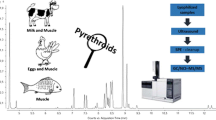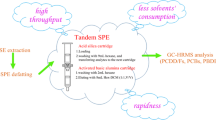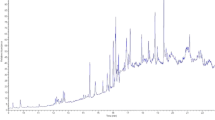Abstract
Organochlorine, organophosphate, and pyrethroid pesticides are extensively used agents, which may result in either chronic or acute intoxication.
Here, multiresidue methods for detecting various components of these pesticide families are presented using different extraction/cleanup techniques and GC-μECD detection. These methods are used for many sample matrices, namely plasma, breast milk, and umbilical cord blood.
Access this chapter
Tax calculation will be finalised at checkout
Purchases are for personal use only
Similar content being viewed by others
References
World Health Organization (2006) Pesticides and their application for the control of vectors and pests of public health importance. https://apps.who.int/iris/handle/10665/69223. Accessed 20 Feb 2021
Porta M, Puigdomènech E, Ballester F (2008) Monitoring concentrations of persistent organic pollutants in the general population: the international experience. Environ Int 34:546–561
United Nations Environment Programme (2010) Ridding the World of POPs: a guide to the Stockholm convention on persistent organic pollutants. http://chm.pops.int/Portals/0/download.aspx?d=UNEP-POPS-PAWA-GUID-RIDDING.En.pdf. Accessed 20 Feb 2021
Heyer DB, Meredith RM (2017) Environmental toxicology: sensitive periods of development and neurodevelopmental disorders. Neurotoxicology 58:23–41. https://doi.org/10.1016/j.neuro.2016.10.017
Dale WE, Curley A, Hayes WJ (1967) Determination of chorinated insecticides in human blood. Ind Med Surg 36(4):275–280
Hovander L, Linderholm L, Athanassiadou M et al (2004) Analysis of PCB and PCB metabolites in humans from Eastern Slovakia. Organohalogen Compd 66:3525–3551
Ramos JJ, Gómara B, Fernández MA et al (2007) A simple and fast method for the simultaneous determination of polychlorinated biphenyls and polybrominated diphenyl ethers in small volumes of human serum. J Chromatogr A 1152:124–129
United States Environmental Protection Agency (2018) SW-846 Test Method 8000D: determinative chromatographic separations. https://www.epa.gov/hw-sw846/sw-846-test-method-8000d-determinative-chromatographic-separations. Accessed 20 Feb 2021
Stroia NG, Álvarez GB, Rodríguez Girault ME et al (2019) Evaluación de los niveles de plaguicidas organoclorados en población general de Argentina desde el 2005 al 2018. Acta Toxicol Argent 27(Supl):60–61
Dirtu AC, Cernat R, Dragan D et al (2006) Organohalogenated pollutants in human serum from Iassy, Romania and their relation with age and gender. Environ Int 32(6):797–803. https://doi.org/10.1016/j.envint.2006.04.002
Petrik J, Drobna B, Pavuk M et al (2006) Serum PCBs and organochlorine pesticides in Slovakia: age, gender, and residence as determinants of organochlorine concentrations. Chemosphere 65:410–418
Thomas GO, Wilkinson M, Hodson S et al (2005) Organohalogen chemicals in human blood from the United Kingdom. Environ Pollut 141(1):30–41. https://doi.org/10.1016/j.envpol.2005.08.027
Carreño J, Rivas A, Granada A et al (2007) Exposure of young men to organochlorine pesticides in Southern Spain. Environ Res 103:55–61
Lucero P, Nassetta M, De Romedi A (2008) Evaluación de la exposición ambiental a plaguicidas orgánicos persistentes en dos barrios de la provincia de Córdoba. Acta Toxicol Argent 16(2):41–46
Kalantzi OI, Geens T, Covaci A et al (2011) Distribution of polybrominated diphenyl ethers (PBDEs) and other persistent organic pollutants in human serum from Greece. Environ Int 37(2):349–353. https://doi.org/10.1016/j.envint.2010.10.005
Mishra K, Sharma RC, Kumar S (2011) Organochlorine pollutants in human blood and their relation with age, gender and habitat from North-east India. Chemosphere 85(3):454–464. https://doi.org/10.1016/j.chemosphere.2011.07.074
Amodio E, Turci R, Massenti MF et al (2012) Serum concentrations of persistent organic pollutants (POPs) in the inhabitants of a Sicilian city. Chemosphere 89(8):970–974. https://doi.org/10.1016/j.chemosphere.2012.06.054
Arrebola JP, Cuellar M, Claure E et al (2012) Concentrations of organochlorine pesticides and polychlorinated biphenyls in human serum and adipose tissue from Bolivia. Environ Res 112:40–47. https://doi.org/10.1016/j.envres.2011.10.006
Ruiz-Suárez LE, Castro-Chan RA, Rivero-Pérez NE et al (2014) Levels of organochlorine pesticides in blood plasma from residents of malaria-endemic communities in Chiapas, Mexico. Int J Environ Res Public Health 11(10):10444–10460. https://doi.org/10.3390/ijerph111010444
Waliszewski SM, Caba M, Gómez-Arroyo S et al (2015) Niveles de plaguicidas organoclorados en suero sanguíneo comparados con la concentración de lípidos sanguíneos. Rev Int Contam Ambie 31(2):155–164
Bedi JS, Gill JP, Kaur P et al (2015) Evaluation of pesticide residues in human blood samples from Punjab (India). Vet World 8(1):66–71. https://doi.org/10.14202/vetworld.2015.66-71
Kim JT, Kang JH, Chang YS et al (2018) Determinants of serum organochlorine pesticide and polychlorinated biphenyl levels in middle-aged Korean adults. Environ Sci Pollut Res Int 25(1):249–259. https://doi.org/10.1007/s11356-017-0382-7
Li J, Wang P, Shi S et al (2018) Background biomonitoring of residue levels of 137 pesticides in the blood plasma of the general population in Beijing. Environ Monit Assess 190(5):315. https://doi.org/10.1007/s10661-018-6694-3
Mansouri EH, Reggabi M (2021) Plasma concentrations of chlorinated persistent organic pollutants and their predictors in the general population of Algiers, Algeria. Emerg Contam 7:35–42. https://doi.org/10.1016/j.emcon.2020.12.003
Rodríguez Girault ME, Álvarez GB, Eisenacht M et al (2018) Exposición prenatal a plaguicidas organoclorados. Evaluación de los niveles en sangre de cordón umbilical en neonatos del área metropolitana de Buenos Aires. Acta Toxicol Argent 26(Supl):11
Jaraczewska K, Lulek J, Covaci A et al (2006) Distribution of polychlorinated biphenyls, organochlorine pesticides and polybrominated diphenyl ethers in human umbilical cord serum, maternal serum and milk from Wielkopolska region, Poland. Sci Total Environ 372(1):20–31
Pathak R, Suke SG, Ahmed RS et al (2008) Endosulfan and other organochlorine pesticide residues in maternal and cord blood in North Indian population. Bull Environ Contam Toxicol 81(2):216–219. https://doi.org/10.1007/s00128-008-9459-9
Herrero-Mercado M, Waliszewski SM, Caba M et al (2010) Organochlorine pesticide levels in umbilical cord blood of newborn in Veracruz, Mexico. Bull Environ Contam Toxicol 85(4):367–371. https://doi.org/10.1007/s00128-010-0108-8
Sexton K, Salinas JJ, McDonald TJ et al (2013) Biomarkers of maternal and fetal exposure to organochlorine pesticides measured in pregnant Hispanic women from Brownsville, Texas. Int J Environ Res Public Health 10(1):237–248
Vizcaino E, Grimalt JO, Fernández-Somoano A et al (2014) Transport of persistent organic pollutants across the human placenta. Environ Int 65:107–115. https://doi.org/10.1016/j.envint.2014.01.004
Guo H, Jin Y, Cheng Y et al (2014) Prenatal exposure to organochlorine pesticides and infant birth weight in China. Chemosphere 110:1–7
Luo D, Pu Y, Tian H et al (2016) Concentrations of organochlorine pesticides in umbilical cord blood and related lifestyle and dietary intake factors among pregnant women of the Huaihe River Basin in China. Environ Int 92-93:276–283. https://doi.org/10.1016/j.envint.2016.04.017
Choi S, Kim HJ, Kim S et al (2018) Current status of organochlorine pesticides (OCPs) and polychlorinated biphenyls (PCBs) exposure among mothers and their babies of Korea-CHECK cohort study. Sci Total Environ 618:674–681. https://doi.org/10.1016/j.scitotenv.2017.07.232
Zhang X, Wu X, Lei B et al (2018) Transplacental transfer characteristics of organochlorine pesticides in paired maternal and cord sera, and placentas and possible influencing factors. Environ Pollut 233:446–454. https://doi.org/10.1016/j.envpol.2017.10.075
Rosell MG, Obiols J, Berenguer MJ et al (1993) Determination of chlorinated insecticides in blood samples of agricultural workers. J Chromatogr 655:151–154
Guardino X, Serra C, Obiols J et al (1996) Determination of DDT and related compounds in bood samples from agricultural workers. J Chromatogr A 719:141–147
Luo XW, Foo SC, Ong HY (1997) Serum DDT and DDE levels in Singapore General Population. Sci Total Environ 208:97–104
Garrido Frenich A, Martinez Vidal JL, Moreno Frías M et al (2000) Quantitative determination of endocrine-disrupting polychlorinated biphenyls and organochlorinated pesticides in human serum using gas chromatography with electron-capture detection and tándem mass spectrometry. J Mass Spectrom 35:967–975
Martinez Vidal JL, Moreno Frías M et al (2000) Trace determination of α- and β-endosulfan and three metabolites in human serum by gas chromatography electron capture detection and gas chromatography tandem mass spectrometry. Rapid Commun Mass Spectrom 14:939–946
Pitarch E, López FJ, Serrano R et al (2001) Multiresidue determination of organophosphorus and organochlorine in human biological fluids by capillary gas chromatography. Fresenius J Anal Chem 369:502–509
Stevens MF, Ebell GF, Psaila-Savona P (1993) Organochlorine pesticides in western Australian nursing mothers. Med J Aust 158:238–241
Waliszewski SM, Pardo Sedas VT, Chantiri JN et al (1996) Organochlorine pesticides residue in human milk from tropical areas in Mexico. Bull Environ Contam Toxicol 57:22–28
Lenardon A, Maitre MI, Lorenzeti E et al (2000) Plaguicidas organoclorados en leche materna en Santa Fe, Argentina. Acta Toxicol Argent 8(1):2–4
Luo D, Pua Y, Tian H et al (2016) Concentrations of organochlorine pesticides in umbilical cord blood and related lifestyle and dietary intake factors among pregnant women of the Huaihe River Basin in China. Environ Int 92–93:276–283
Lopes B, Arrebola JP, Serafim A et al (2014) Polychlorinated biphenyls (PCBs) and p,p 0-dichlorodiphenyldichloroethylene (DDE) concentrations in maternal and umbilical cord serum in a human cohort from South Portugal. Chemosphere 114:291–302
Author information
Authors and Affiliations
Corresponding author
Editor information
Editors and Affiliations
Rights and permissions
Copyright information
© 2022 The Author(s), under exclusive license to Springer Science+Business Media, LLC, part of Springer Nature
About this protocol
Cite this protocol
Fernández, N., Alvarez, G.B., Girault, M.E.R., Quiroga, P.N., Ridolfi, A.S. (2022). Residue Analysis of Organochlorine, Organophosphate, and Pyrethroid Pesticides in Human Biological Specimens by Gas Chromatography–Microelectron Capture Detector (GC-μECD). In: Gallardo, E., Barroso, M. (eds) Pesticide Toxicology. Methods in Pharmacology and Toxicology. Humana, New York, NY. https://doi.org/10.1007/978-1-0716-1928-5_7
Download citation
DOI: https://doi.org/10.1007/978-1-0716-1928-5_7
Published:
Publisher Name: Humana, New York, NY
Print ISBN: 978-1-0716-1927-8
Online ISBN: 978-1-0716-1928-5
eBook Packages: Springer Protocols




